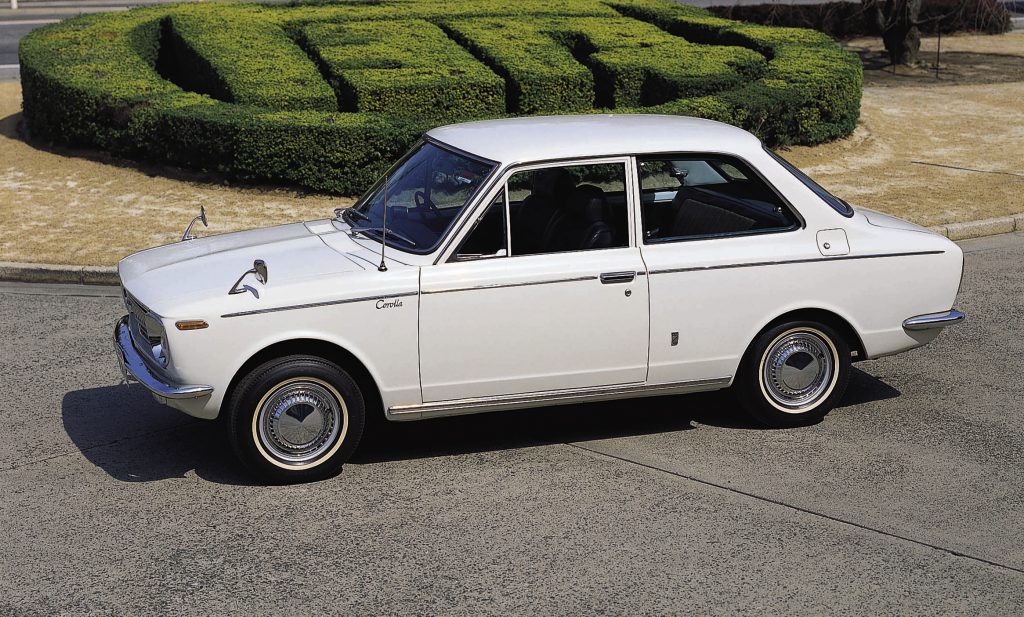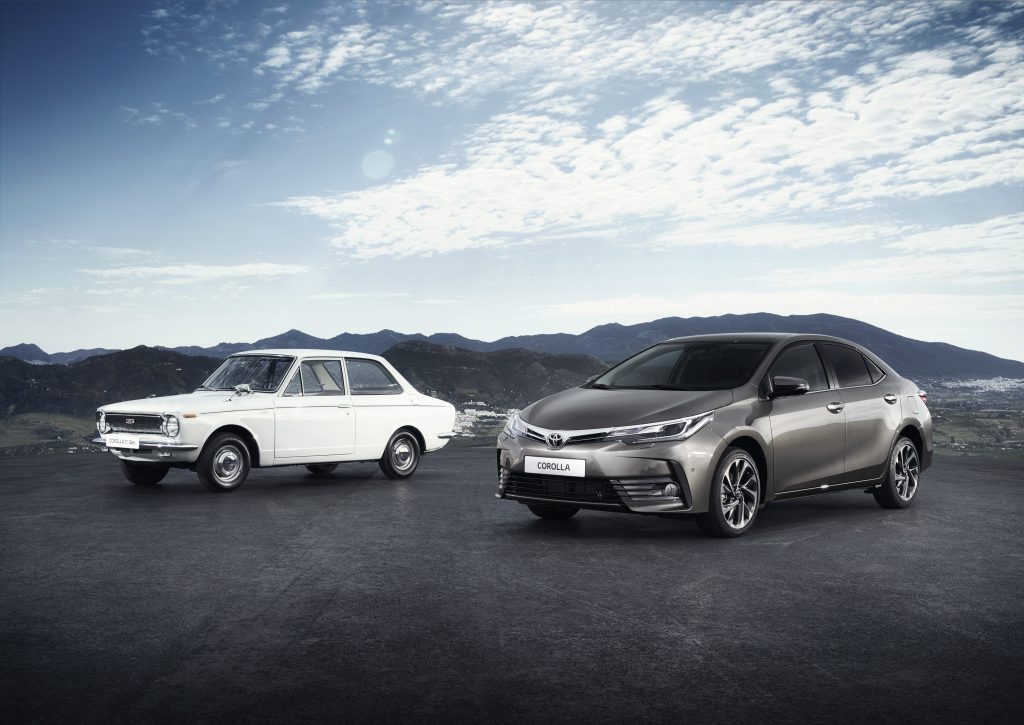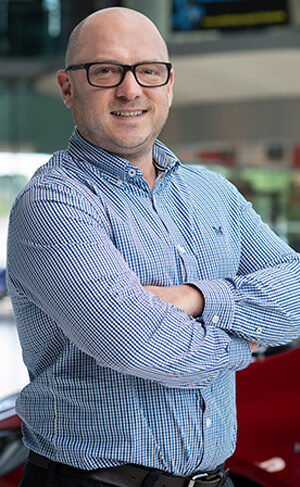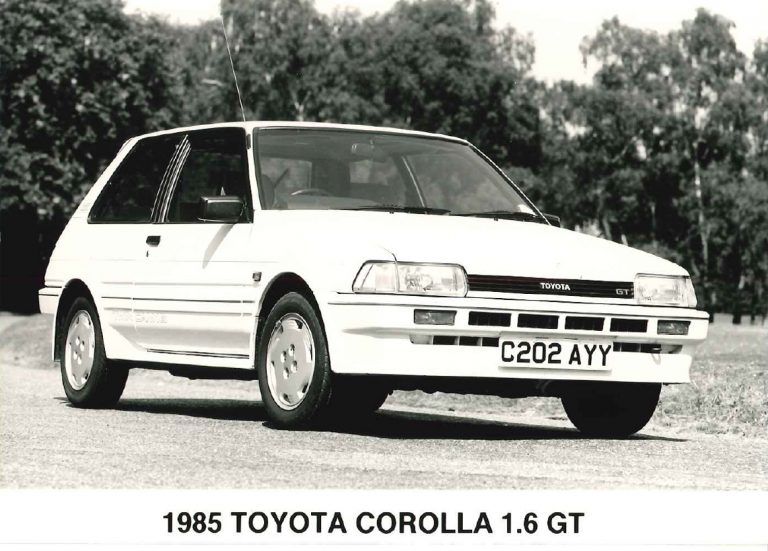Toyota Corolla: 50 Years of the World’s Best-Selling Car
- Fiftieth anniversary of the Toyota Corolla, the world’s most popular car
- More than 44 million sales in 150 countries
- Distinguished history in the UK, including local production at Toyota’s Burnaston factory and back-to-back British Touring Car Championship titles
This year the Toyota Corolla reaches its 50th anniversary, another milestone for the world’s most popular car. Since the original model was introduced in Japan in 1966, more than 44 million have been sold worldwide.
Although Corolla has not been part of the UK model range since 2008, it remains an important part of Toyota’s global line-up, manufactured in 16 plants worldwide. Its lasting popularity is reflected in the fact that one in every five new vehicles sold in Toyota’s 79-year history has been a Corolla.
For a full gallery of every generation of Corolla, click here.
Corolla origins
Corolla was designed to be a “people’s car,” introduced in saloon and estate body styles and displaying higher build quality and – for its time – lavish equipment features. The specification included a floor-mounted gear lever, individual front bucket seats with generous padding and a spacious rear bench that was likened to a family sofa. Although classed as a compact car, its high roof height made the interior feel exceptionally roomy.
Toyota’s hopes for Corolla (a name drawing on the Latin term for a ‘crown of flowers’) were soon realised with the first generation model becoming Japan’s top-selling vehicle within three years. The success quickly spread to other countries around the world.
In developing each of Corolla’s 11 generations, Toyota has remained true to its original principles of building a car with superior quality, reliability and durability. And with each new model, it has analysed customer feedback to ensure Corolla continues to deliver what its customers want.
Corolla in the UK
Corolla was Toyota’s second model to be imported into the UK, following the Corona into showrooms within its launch year, 1966. Through successive generations and a wide range of body styles, it continued to be available up to 2008 when the Corolla name was dropped from the original Verso compact MPV. Within that timespan it achieved more than 560,000 sales.
Its popularity here and in Europe prompted Toyota to build five-door hatchback models at its Burnaston factory in Derbyshire between 1988 and 2006. Production ended to make way for Auris, Toyota’s new (and current) compact hatchback for the European market.
Although renowned as an appealing family car for everyday driving, Corolla demonstrated its genuine performance edge in UK motorsports. The famous Corolla GT rear-wheel drive coupe was driven by Chris Hodgetts to victory in the 1986 British Touring Car Championship – a feat he repeated the following year.
Production history
Toyota opened a new, purpose-built factory in Takaoka for the original Corolla and within two years had started production of region-specific versions in Australia and Malaysia. Annual production more than doubled to 1.1 million by 1968.
In addition to being built in the UK, Corolla has also been manufactured at Toyota’s Sakarya plant in Turkey – the factory has been producing the 11th generation model since 2013.
Corolla exports to North America began in 1968, helping the model reach its first million sales by 1970. It has enjoyed the status of being the world’s best-selling model since 1997, when cumulative sales reached 22.65 million; by 2013, that figure passed through the four million mark.
| 1st Generation Corolla (1966-1970) |
| 1966 saw the birth of Corolla. Led by development leader Tatsuo Hasegawa, the Corolla designers set out to capture the hearts of the general public. The leading principle in this programme was to create a car that was sporty in both look and feel. This revolutionary new model was offered in a variety of body styles and adopted many new technologies not seen in the Japanese market before, such as MacPherson strut suspension and a four-speed transmission. The model line-up consisted of a two and four-door saloons and a two-door estate. |
| 2nd Generation Corolla (1970-1974) |
| With production of the first generation Corolla coming to an end, the engineers and designers had the challenge of building on the success of this first model with its successor. In the year that the one millionth Corolla was built, this new model was designed to be an ‘all new Corolla’. While the exterior styling evolved with gently curved surface lines, under the body a larger rear leaf suspension made advances in ride comfort and handling.In 1972, the line-up expanded to four body types with the launch of a coupe. With its renowned 2T-G engine, the Corolla Levin proved to be the sports car lover’s choice. |
| 3rd Generation Corolla (1974-1979) |
| 1974 proved to be a demanding year for the launch of the next generation Corolla. Strict emission regulations meant that engine and exhaust systems had to be developed to clear the new model for sale. As a result, Toyota pioneered the development of the catalytic converters that are still being used today. This cleaner, more efficient Corolla also benefited from another modern advance -the wind tunnel- and the results from this influenced the exterior design’s ability to cut through the air more efficiently. Inside, interior quality and ergonomics improved with Corolla feeling like a car from a higher price bracket. |
| 4th Generation Corolla (1979-1983) |
| In 1979, and with another oil crisis behind it, the Japanese economy appeared to be on the mend. With the background of this renewed optimism, the fourth generation Corolla entered the world stage. It was re-imagined as a luxurious but economical family car with superior overall performance to meet diverse user needs. As aerodynamics played more of a part in vehicle design, the new Corolla would spend more than 400 hours being honed in the wind tunnel. To avoid being a radical departure in design and feel for the increasingly loyal fan-base, the Corolla evolved seamlessly with sharp lines across a more squared-off style. Under the skin, comfort and stability improved with a new four-link coil suspension and to satisfy environmental pressures a new 1.8 litre diesel engine was introduced. |
| 5th Generation Corolla (1983-1987) |
| In his role as development leader Fumio Agetsuma set out to make the fifth generation Corolla as innovative a car as he could, saying that it should incorporate breakthroughs in every area. This new model was the first to be engineered with the aid of computers, saving time and resources in the design of the engine and exterior. With its slanted nose and rounded wedge shape it would be the first in the series to feature front-wheeldrive – a real challenge for the engineers.Rear-wheel drive coupe models emphasised sporty driving characteristics by using either 1.5 or 1.6-litre engines, mounted longitudinally. This latter variation, frequently known as the Hachi-Roku (or ‘eight-six’ in Japanese) in reference to its ‘AE86’ chassis code, was the last Corolla with a FR drivetrain. Its numerous race and rally successes, not to mention its lead role in popularising the sport of drifting, has made this model one of the best-known vehicles in Toyota’s modern history. |
| 6th Generation Corolla (1987-1991) |
| 1987 and the key word in the development of the new Corolla was ‘quality,’ both in how the car felt and how it would make the owners feel. It was critical to the engineers that this new car didn’t just satisfy the owners but excited them with greater quality. More than 2,000 improvements were proposed to make all areas of the car perform better, from reducing noise levels to introducing soft touch materials across the dashboard and switches. This would be the best quality Corolla so far. |
| 7th Generation Corolla (1991-1995) |
| 1991 witnessed the launch of the seventh generation Corolla. Developed to appeal with charisma and personality around three core themes: style in design, driving performance and safety and reliability. The engineers focused on the small details that matter and providing ample room for the family, aiming to create a car that would provide deeper owner satisfaction. |
| 8th Generation Corolla (1995-2000) |
| 1995 was a time of environmental and economic considerations, not least for the developers of the eighth generation Corolla. With a sluggish economy in the home country, the development team set out to make a new car that consumers demanded: one that reduced the impact on the planet and was more efficient and cheaper to own and maintain. What they got was just that -a car that transcended generations and nationalities by evolving to become the number one selling car in Japan- reducing the total cost of ownership and providing them a safer, quieter and higher quality compact car. |
| 9th Generation Corolla (2000-2006) |
| 2000 brought with it the launch of the ninth generation Corolla and a design created in Europe for the first time. Tasked with breaking links with the past and setting standards for the 21st century, this new model was designed from scratch with affordability at its heart. Along with ease of use and reliability, a high level of interior finish and comfort to rival higher segments were its hallmarks. |
| 10th Generation Corolla (2006-2013) |
| 2006 saw a significant milestone in the story of the Corolla as it reached the 40th anniversary of sales beginning in Japan. With the 10th generation launch came a new design direction. The development leader for this model, Soichiro Okudaira, set out to make the new car a model with a truly global perspective and scale. Dynamic performance was benchmarked with the best in Europe, while ease of use and space had to measure up for the North American market. Through its development, the engineers worked to a five-minute impression rule, where customers would recognise the quality of this new model within five minutes of their first drive. |
| 11th Generation Corolla (since 2013) |
| 2013 brought the 11th generation Corolla into the world with a bang as the Toyota model celebrated the title of the ‘world’s best-selling car’. The launch of this latest model introduced a new prestigious exterior styling, a strong focus on sensory quality and higher levels of technology and safety equipment. |
For more in depth information on Corolla, visit the Corolla Archive





